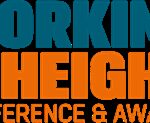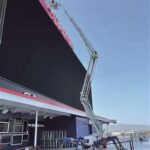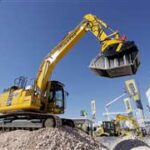You’ve got high ceilings.
You’ve got light fixtures, ductwork, banners, sprinklers—all begging for attention.
You’re thinking:
“Should I bring in a boom lift and make this easy?”
Smart move—or potential disaster?
Let’s find out before you roll a 12,000-pound machine across the polished marble floor.
🧠 Short Answer: It Can Be Genius—If You Know What You’re Doing
Yes, you can absolutely use a boom lift indoors.
But, you need the right type, the right prep, and the right mindset.
Otherwise, you might end up explaining to the building owner why the brand-new tiles now resemble the surface of the moon.
🚀 When Boom Lifts Indoors Make Total Sense
-
Ceiling repairs in warehouses or malls
-
Electrical installs in atriums or airports
-
Sprinkler or HVAC maintenance in factories
-
Hanging heavy signage or lighting rigs at events
-
Accessing high mezzanine structures
Basically, any place where a ladder would cause a lawsuit, and scaffolding would take two weeks.
Boom lifts = fast, safe, efficient indoor access—when done right.
⚙️ The Right Boom Lift for Indoor Work
✅ Electric Boom Lifts Only
-
Zero emissions
-
Low noise
-
Compact drive systems
Popular picks:
-
Genie Z-34/22N (narrow aisle champ)
-
JLG E450AJ (mid-range, great reach)
-
Haulotte HA20 LE PRO (eco-friendly hybrid)
✅ Non-Marking Tires
You don’t want black scuff trails on pristine showroom floors.
Look for solid, white, non-marking rubber tires.
✅ Compact Width
You’ll need to squeeze through doorways, aisles, and other indoor obstacles.
Narrow-chassis booms (around 4 ft wide) are your best friends.
🚫 When Boom Lifts Indoors Turn Into Nightmares
-
Using a diesel engine indoors: hello, carbon monoxide alarms.
-
Trying to maneuver a 10-ton diesel beast in a shopping mall: goodbye, customer patience (and floor tiles).
-
Ignoring floor load limits: congratulations, you’ve built a brand-new skylight.
📋 Indoor Boom Lift Prep Checklist
Before you even move the machine inside:
-
Check Floor Load Ratings
Concrete slabs, mezzanines, and specialty floors have weight limits.
The GS-3232 weighs over 5,000 lbs; heavier booms double that. -
Measure Everything
Doorways. Aisles. Ceiling heights.
Bonus points if you check turning radii and platform swing clearances. -
Plan for Charging Access
Electric boom lifts need juice.
Make sure you’ve got power outlets nearby, or charge overnight. -
Prep a Spotter
Indoor driving = blind corners + people + glass panels.
A ground spotter helps prevent expensive “oops” moments.
💡 Pro Tips for Indoor Boom Success
-
Drive slow. Turtle slow. Indoor spaces aren’t forgiving.
-
Mind overhead obstructions—especially sprinkler pipes and chandeliers.
-
Watch for slope transitions (loading docks, ramps) that could affect stability.
-
Never assume floor strength—know it.
🛠️ Bonus: Alternatives to Big Booms
If the indoor space is super tight, consider:
-
Vertical mast lifts (Genie GR series) for ultra-compact vertical work
-
Small electric articulating booms for agile maneuvering
-
Scissor lifts for straight-up, high-capacity work
Choosing the right tool saves time, budget, and face.
🏁 Final Thoughts
Using a boom lift indoors?
✅ Genius—if you pick electric models, plan safely, and measure twice, lift once.
❌ Disaster—if you roll in a diesel beast without checking floor specs.
Indoor boom lifts are game changers for maintenance, construction, and event setups.
Use them smartly, and you’ll wonder how you ever got by with ladders and prayers.
Remember: when it comes to working high indoors, it’s not about muscle—it’s about moves and mind.




